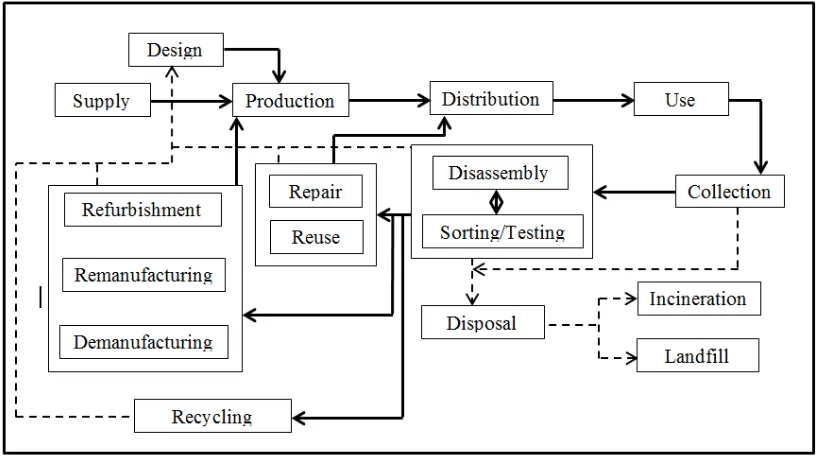APPLICATION OF AHP METHOD IN THE DESIGN OF
REMANUFACTURING IMPROVEMENT PROCESSES FOR
CRANKSHAFT
This report submitted in accordance with requirement of the Universiti Teknikal Malaysia Melaka (UTeM) for the Bachelor Degree of Manufacturing Engineering
(Manufacturing Design) (Hons.)
by
MUHAMMAD AIMI BIN ABU HASSAN B051010054
880402145615
ABSTRACT
ABSTRAK
DEDICATION
ACKNOWLEDGEMENT
4.5 MTI Facility 36
CHAPTER 5: HIERARCHICAL END OF LIFE DECISION MODEL AND ANALYTIC HIERARCHICAL PROCESS (AHP)
5.3.6.3 Finally, Calculate the Consistency Ratio (CR) 72 5.3.7 Step 7: Step (3-6) are performed for all level in the hierarchy 73 5.3.8 Step 8: Develop Overall Priority Ranking 76
CHAPTER 6: RESULT AND DISCUSSION
6.1 Result 79
6.2 Discussion 80
CHAPTER 7: CONCLUSION AND RECOMMENDATION
7.1 Conclusion 83
7.2 Recommendation 84
REFERENCES 85
LIST OF TABLE
2.1 Remanufactured guideline 9
2.2 Product design to facilitate individual processes in remanufacturing 15
4.13 Side view 45 5.23 Hierarchical structures for selecting the critical defect in the crankshaft 65
LIST OF ABBREVIATIONS, SYMBOLS AND
NOMENCLATURES
EOL - End of life
CLSC - Closed loop supply chain PDCA - Plan do check act
AHP - Analytic Hierarchical Process CR - Consistency Ratio
CHAPTER 2
LITERATURE REVIEW
2.1 Introduction
This chapter will discuss the literature review on remanufacturing. It started with an introduction about remanufacturing and its function. The element in remanufacturing and major environmental impact for remanufacturing will be reviewed in this chapter. This chapter also presents the advantages of remanufacturing, a policy framework for remanufacturing, barriers in remanufacturing and difference between design environments, design for reused and design for remanufacturing.
2.2 History of Remanufacturing
activities in 1970. In 1990 a company called Fuji Xerox started its remanufacturing activities. After seeing the profits generated by the Fuji Xerox Company, other companies began to see the remanufacturing activity as an activity that will give advantage to tie up. In year 2000, Ricoh and Canon started applying the remanufacturing activities in their company.
2.3 Major Environmental Problem
According Amezquita et al. (1995), every year the United States produced 700 million tons of hazardous waste and 11 billion tons of hazardous waste caused by the extraction, processing and manufacturing of materials. In 1990, more than 190 million tons of solid waste were generated in the United States where nearly 87% is generated waste material by the extraction, processing and manufacturing required in producing a product. For maintaining a safe and secure ecosystem, Amezquita et al. (1995) and Ijomah (2009) suggested that the remanufacturing activities should be carried out in each country, because remanufacturing can reduce pollution and the cost of the landfill. Besides that, remanufacturing also can reduce the use of raw materials, waste disposal and water.
2.4 Definition of Remanufacturing
remanufacturing is a process that uses the product and the installation of a new state back to them with minimum waste and spending on materials and energy that ensures the repair can be carried out on time and the item is returned to the function in an efficient manner.
2.5 Economic Impacts of Remanufacturing
Normally a company or a country must be conscious of their profit for a long term before starting an activity or a project. One of the activities that can guarantee good returns and profits are remanufacturing activities. According to Ron Giuntini, (1993) the product has been manufactured mostly just need cost 40 percent to 65 percent less than the production of new products, while the energy consumption of manufacturing also takes 15 percent of the energy needed in manufacturing; due to the activities remanufacturing process requires only a small part in the production of new products. One example of an activity that has been applied remanufacturing is an automotive activity, which Holzwasser, (1997) estimates that the manufacturing process can save 8.2 million of crude oil in the manufacture of steel, 51 500 tons of iron ore and 6000 tons of copper. This was supported by Hauser and Lund (2003) who claimed remanufacturing activities could benefit 1 million to 2 million per year.
2.6 Elements of Remanufacturing
Table 2.1: Remanufactured guideline
Its main components come from a used product.
The used product is disassemble to the extent necessary to determine the condition of its components
The used product's parts are thoroughly cleaned and made free from rust and corrosion.
All missing, defective, broken or substantially worn parts are either recovered to sound, functionally good state, or they are change with new, remanufactured, or sound, functionally good used parts
To put the product in sound working state, such machining, rewinding, refinishing or other operations are conducted as necessary.
The product is reinstallation and a determination is made that it will work like a similar new product.
Figure 2.1: A framework for reverse supply chain activities
Figure 2.1 shows the framework for reverse logistics, describes about the remanufacturing process and the sequence of the process which disassembled the parts were in some are fitted into remanufacturing and some are fitted for recycling (Sasikumar, 2008).
retailer is not involved in the reverse logistic collections. Many remanufacturing companies like Xerox, Canon and Hewlett Packard are collecting products directly from customers.
Figure 2.2: Manufacturer collects from consumer.
Figure 2.3 shows about the sequence involving of retailers in the collection of end of life product from the consumer, which is retailers supply the end of life product to the manufacturer. Usually Consumer always feels comfortable to return end of life product to retailers, for example camera, television, refrigerators are returned from consumer to the retailer. Usually most of the remanufacturers adopted this method.
Figure2.3: Retailers collect from consumers.

